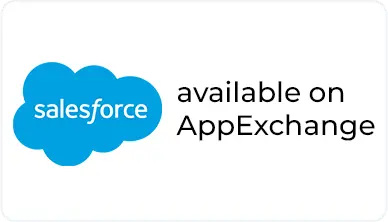
Boost Your Sales with a Salesforce WhatsApp Chatbot: Everything You Need to Know
In today's digital age, customer interaction has evolved, and businesses need to adapt to these changes to stay ahead. One of the most effective ways to boost sales and enhance customer engagement is by using a Salesforce WhatsApp Chatbot. This blog will guide you through the benefits, setup, and best practices of integrating a WhatsApp chatbot with Salesforce.
The Benefits of Using a Chatbot for Sales
Sales chatbots can transform the way businesses interact with customers. Here are some key benefits :
- 24/7 Availability: Chatbots can provide round-the-clock customer service, ensuring that no potential sale is missed.
- Instant Responses: Quick responses to customer queries can significantly improve customer satisfaction and conversion rates.
- Scalability: Chatbots can handle multiple conversations simultaneously, making them highly scalable.
- Data Collection: Chatbots can gather valuable customer data that can be used to personalise marketing efforts and improve sales strategies.
- Cost Efficiency: Automating customer interactions can reduce the need for a large sales team, lowering operational costs.
Understanding WhatsApp as a Sales Channel
WhatsApp is one of the most widely used messaging apps globally, making it a powerful tool for sales. Here's why :
- Wide Reach: With over 2 billion users worldwide, WhatsApp offers an extensive audience.
- High Engagement: Users tend to check WhatsApp frequently, leading to higher engagement rates compared to emails or other messaging platforms.
- Rich Media Support: WhatsApp supports images, videos, and voice messages, allowing for more engaging interactions.
- Data Collection: Chatbots can gather valuable customer data that can be used to personalise marketing efforts and improve sales strategies.
- End-to-End Encryption: Ensures that customer data is secure, building trust with your audience.
How Salesforce Integration with WhatsApp Works
Integrating WhatsApp with Salesforce involves connecting your WhatsApp Business API to Salesforce. This enables seamless communication between your sales team and customers directly through WhatsApp. Key features of this integration include :
- Unified Interface: Manage all customer interactions from within Salesforce.
- Automated Workflows: Automate responses and follow-ups based on customer interactions.
- CRM Integration: Sync customer data from WhatsApp interactions directly to your Salesforce CRM.
- Analytics: Track and analyse the performance of your WhatsApp campaigns.
Setting up a WhatsApp Chatbot in Salesforce
Setting up a WhatsApp chatbot in Salesforce involves several steps:
- Get WhatsApp Business API Access: Apply for and set up your WhatsApp Business API.
- Integrate with Salesforce: Use a connector or middleware to link your WhatsApp Business API with Salesforce.
- Create Chatbot Flows: Design the conversation flows that your chatbot will follow.
- Test and Deploy: Thoroughly test your chatbot to ensure it works seamlessly before deploying it to live users.
Designing Conversational Flows for Sales
Effective conversational flows are critical to a successful sales chatbot. Here are some tips:
- Define Objectives: Clearly define what you want to achieve with your chatbot (e.g., lead generation, customer support).
- Script Engaging Conversations: Create engaging and natural-sounding scripts for your chatbot.
- Include CTAs: Use clear calls-to-action to guide customers towards making a purchase.
- Handle FAQs: Include responses to frequently asked questions to provide quick assistance.
- Personalise Interactions: Use customer data to personalise conversations and enhance engagement.
Customising the Chatbot Experience for Your Brand
To ensure your chatbot aligns with your brand, consider the following:
- Brand Voice: Maintain a consistent brand voice in all chatbot interactions.
- Visual Elements: Use your brand colours and logo in the chatbot interface.
- Personalised Messages: Customise messages based on customer preferences and past interactions.
- Feedback Mechanism: Include a way for customers to provide feedback on their chatbot experience.
Measuring Success: Key Metrics for Sales Chatbots
To measure the success of your sales chatbot, track these key metrics :
- Conversion Rate: The percentage of chatbot interactions that lead to sales.
- Customer Satisfaction: Use surveys to gauge customer satisfaction with chatbot interactions.
- Response Time: The average time it takes for the chatbot to respond to customer inquiries
- Engagement Rate: The percentage of users who interact with the chatbot.
- Retention Rate: The percentage of customers who return for future interactions.
Best Practices for Implementing a Salesforce WhatsApp Chatbot
Implementing a successful Salesforce WhatsApp chatbot involves following best practices :
- Regular Updates: Keep your chatbot updated with new information and features.
- Monitor Performance: Regularly monitor and analyse chatbot performance metrics.
- Train Your Team: Ensure your sales team knows how to use and support the chatbot.
- Customer Feedback: Continuously collect and act on customer feedback to improve the chatbot experience.
- Compliance: Ensure your chatbot complies with all relevant data protection regulations.
Conclusion: Leveraging Salesforce WhatsApp Chatbot for Sales Success
Integrating a WhatsApp chatbot with Salesforce can significantly boost your sales and enhance customer engagement. By understanding the benefits, setting up the chatbot correctly, and following best practices, you can leverage this powerful tool to achieve sales success. Embrace this technology to stay ahead in the competitive market and provide exceptional customer service.
Level up WhatsApp Integration with Salesforce
Start with a 30 day trial for you to taste the CRM + WhatsApp interactions!



